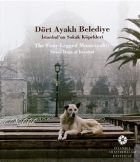Buy or gift a stand-alone digital subscription and get unlimited access to dozens of back issues for just £18.99 / $18.99 a year.
Please register at www.exacteditions.com/digital/cornucopia with your subscriber account number or contact subscriptions@cornucopia.net
Buy a digital subscription Go to the Digital EditionTheir numbers may have thinned but street dogs are still ubiquitous in Istanbul. This fascinating, in places harrowing, exhibition at the Istanbul Research Institute, now extended until April 22, explores their role in Ottoman Istanbul and the shocking impact of Westernisation in the early years of the 20th century
Street dogs have for centuries been part of the fabric of Istanbul. Every corner worth its salt is graced by a noble hound, paws folded. There were more dogs to be seen than fezzes, complained Alka Nestoroff, a Bulgarian diplomat’s wife, in 1908. Then as now, these self-appointed security guards and refuse collectors were beloved of and fed by their two-legged neighbours.
The abiding affection of Istanbullus for vagrant mutts is the subject of The Four-Legged Municipality: Street Dogs of Istanbul (Istanbul Research Institute, Tepebaşı, now until April 22). This is primarily a photographic exhibition, tapping into the institute’s vast collection of historic images, often affording a lovely excuse to air unfamiliar views of familiar sites. But it is harrowing as well as heart-warming.
Not all visitors shared Alka Nestoroff’s disdain. In 1590, the mayor of Danzig painted ‘a benevolent Turk’ feeding both cats and dogs. In 1902, Constantinople’s dogs graced the cover of the Journal des Voyages. But to many uncomprehending European eyes they were part of the backwardness and squalor of the Ottoman capital, with the Pasteur Institute urging that they be rounded up and slaughtered for their skin and bones. Western pressure won the day: in the summer of 1910, they were shipped out in their tens of thousands to a deserted island in the Sea of Marmara, where starving dog would literally eat dog.
Today’s dogs are better managed, chipped and neutered, though a low-level war continues to be waged between dog-loving residents and zealous officials. The outraged populace never forgave the Ottoman administration for the purge. Some would say the empire went to the dogs as a result, and the fez, of course, went the same way.
Yusuf Franko Kusa used brush and pen and position to lampoon and pull the strings of Ottoman high society. Unseen for 60 years, his caricatures are now the subject of a fascinating exhibition in Istanbul, writes K Mehmet Kentel
At one time all roads led to Erzurum, a key stop on a great caravan route and a strategic bastion against invasion. Today it is a remote city on Turkey’s Asian frontier with an important history crying out to be discovered. In Part 2 of Cornucopia’s Beauty and the East series, the photographer Brian McKee continues his tour of eastern Anatolia in Erzurum as Scott Redford leads us from Turkic citadel to Mongol minarets.
It was for centuries the preserve of sultans, extolled by the ancients, sought after in the harem, a staple of palace kitchen and pharmacy. More precious than gold, mastic brought fortune and fame to the island of Chios, today the world’s sole source of this ‘Arabic gum’. Now, thanks to a pioneering initiative, the Turkish shores across the water will be green with mastic groves. Text and photographs by Berrin Torolsan
An ambitious new work of classical music – based on Howard Blake’s enchanting score for ‘The Snowman’ – has just received its world premiere. This concert is just one of many achievements by Talent Unlimited, a Turkish charity that gives budding young virtuosi a helping hand. Tony Barrell tells the story. Photographs: Monica Fritz
And the award for most versatile, most nourishing and best-loved ingredient goes to… the humble chickpea. Berrin Torolsan explores its history and its limitless talent to entertain us in a multitude of different roles


Cornucopia works in partnership with the digital publishing platform Exact Editions to offer individual and institutional subscribers unlimited access to a searchable archive of fascinating back issues and every newly published issue. The digital edition of Cornucopia is available cross-platform on web, iOS and Android and offers a comprehensive search function, allowing the title’s cultural content to be delved into at the touch of a button.
Digital Subscription: £18.99 / $18.99 (1 year)
Subscribe now